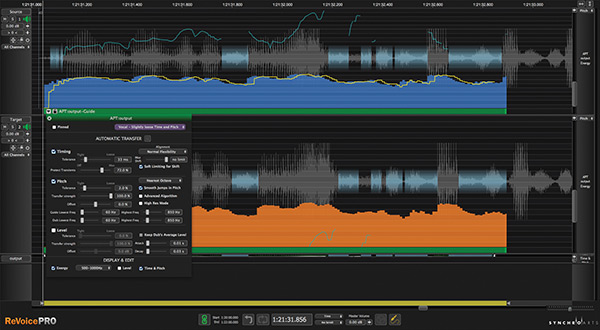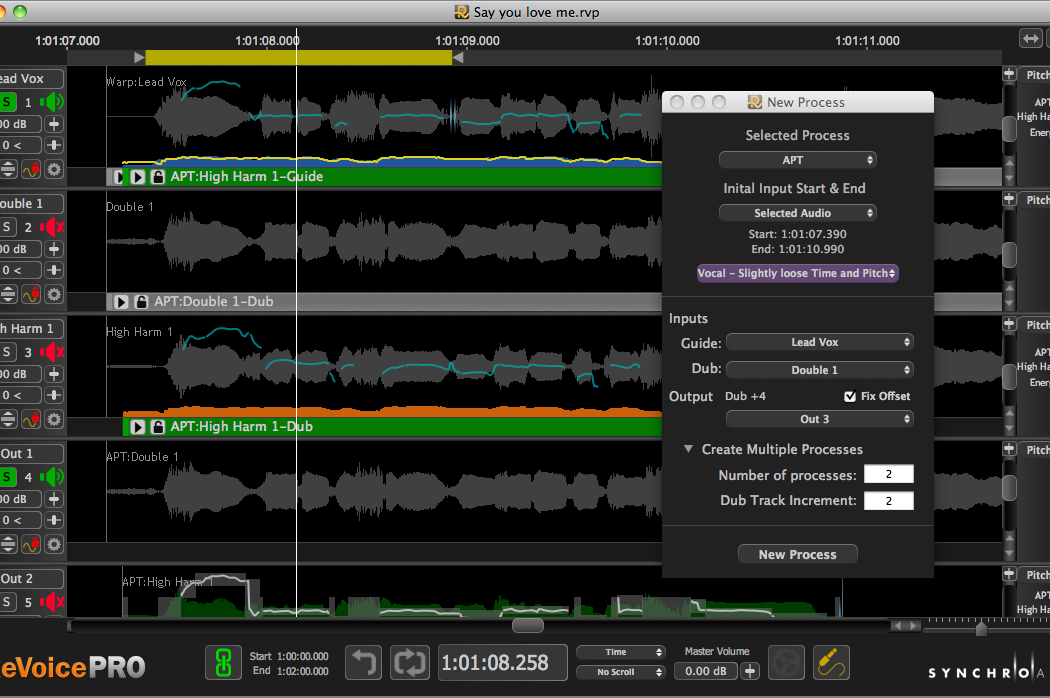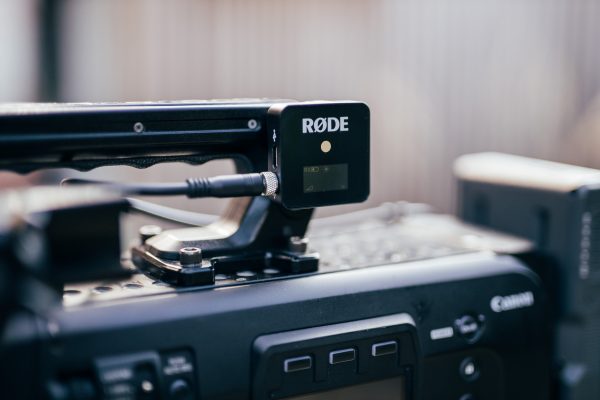With added pitch and timing correction, Revoice Pro 3 is the match for any voice outside of a Tibetan monastery.
Review: Brent Heber
Back in the day, VocAlign was bundled by Digidesign in its DV Toolkit option. It was my first exposure to SynchroArts, which had another massive hit in the post world called Titan (for syncing up location sound after the picture had been cut). Vocalign was pretty good at syncing a dub take to an original take, adjusting syllables and transients to match timing between performances. Revoice Pro takes that concept to a whole new level, matching not just timing, but also pitch and inflection, vibrato and emphasis. It promises a lot!
PLUG-INS LEAVING THE NEST
One of the hurdles I face with software like iZotope RX4 and Revoice Pro 3 is that in my mind they started life as plug-ins inside my favourite DAW and now they’re all grown up and want to be applications, linked to my DAW. They are forcing me to change the way I work. In the case of RX4 I haven’t looked back. On OS X, switching apps with ‘spaces’ and having RX’s output monitored through my PT HD hardware via a plug-in has proven to be a much faster way to work. I was expecting a similar experience with Revoice Pro, but instead found that its monitor plug-in not only piped audio into my HD session but also linked the transport between the apps — a bit like Rewire.
I can see how for many users this may be a benefit, but in my case, being used to a similar but slightly different workflow I found it maddening. I’d fix my clip in Revoice Pro, audition sync in Revoice Pro, and then spot it into my Pro Tools session to hit play and find two versions playing back simultaneously; the version in my mix running through my dialogue plug-in chain, alongside the fixed, but raw, take playing back from Revoice Pro. Revoice Pro’s work had been done, and it was just a distraction by that point. A simple fix was to key a gate off my output, so when transport in PT was engaged, it muted the Revoice Pro monitor return, but it would be nice if this workflow was enabled by a preference or tick box in Revoice Pro.
TARGETED WORKFLOW
Revoice Pro is supported by all the main Mac and PC DAWs, but I was using it with Pro Tools HD, so I’ll be referring to that workflow. With the Revoice Pro app open and the monitor plug-in inserted on an aux, you can now find an audio region to fix, select it and open the Revoice Pro Connect Audiosuite plug-in. The ‘Send’ button transports the audio to a chosen track inside the Revoice Pro application.
You can have multiple tracks inside Revoice Pro because you often need to compare two or more pieces of audio; like your source and a target track to time align it to, for instance. If you’re processing backing vocals you may want to work with a whole stack of tracks inside Revoice Pro. So, when sending audio from your host DAW, you need to assign it to an appropriate track in Revoice Pro from the pull down in the Audiosuite plug-in. Once your source and target audio are in Revoice Pro, the fun starts!
THE APT TOUR
Revoice Pro provides a few different functions: Audio Performance Transfer (APT), Doubler and Warp. APT is ideal for post production applications, where you want to take an on-location performance and apply its characteristics to an ADR track. The scope for music-related APT applications is similarly wide; lining up double tracks is an obvious one, and if you’re trying to match live vocals to a pre-recorded take for video, it’s a life saver.
Where Vocalign only matched timing, the APT function builds on this with options to match pitch across the take and intensity/volume changes as well. Of course, you also have comprehensive control over how much of these characteristics are applied, through a pop up window with excellent parameter depth. The system also has a comprehensive preset menu, allowing settings to be easily recalled from job to job, character to character.
Doubler is primarily for synthesising a double of a take when one hasn’t been recorded, while providing the nuance and elements of randomness associated with a real double track. Incorporating formant and vibrato controls, you get some very good results. This function, and a basic version of APT, are also available as separate Audiosuite plug-ins inside Pro Tools, however both still require the host Revoice Pro application to be running in the background to work, which is a small shame.
Lastly we have the Warp function. This gives complete freedom to manipulate audio with all the pitch, vibrato, timing and energy aspects available for manual interaction. The GUI is pretty good, given the amount of control. Using three Warp points, you can manually adjust timing, and a pitch tracking line lets you interact with the material in much the same way as other software in this field — though the audio itself is represented as a standard waveform, not as blobs. One other caveat is that it’s primarily a vocal application, so while you can work with other instruments, the pitch correction element is monophonic only.
RE-PITCHING THE PACKAGE
Revoice Pro’s results do not disappoint. The maths at the heart of its code is clearly solid, the results often cleaner and less watery than the competition, reinforcing the old mantra, ‘you get what you pay for’. Add to that the many best-of-breed functions together in a single package and you may find you are replacing two arguably more clumsy tools with a single integrated interface/workflow.
I have some minor issues with the GUI and workflow, but the results are what matters and they are very, very good. A must-have upgrade from VocAlign for anyone doing lots of ADR work and music producers will love the added power and ease this tool brings to their world of vocal production.
NEED TO KNOW
PRICE: Full License: £374
CONTACT: Synchro Arts, +44 1372 811934 or sales@synchroarts.com
PROS:
- Better algorithms, faster processing
- Wider appeal with new pitch & time warping
- All-in-one vocal correction suite
CONS:
- Transport between DAW and app not unlinkable,
- GUI not immediately intuitive
SUMMARY:
Version three breaks Revoice Pro into mass appeal as they add best-of-breed pitch manipulation to an already powerful syncing product. Good for music producers, amazing for those in post production.





